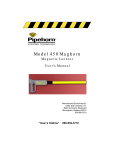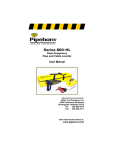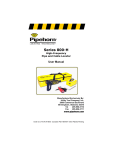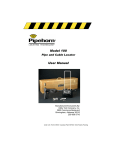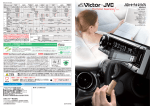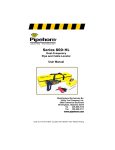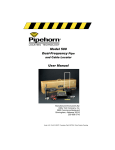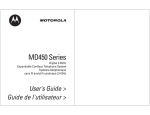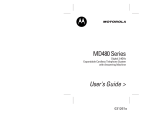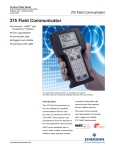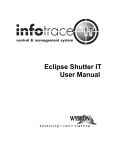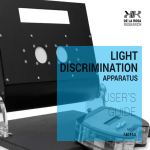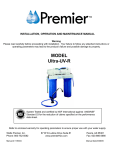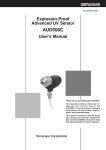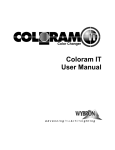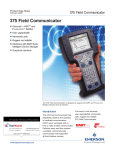Download Model 450 Mag Horn
Transcript
Model 450 Mag Horn Ferromagnetic Locator User’s Manual Manufactured Exclusively By: Utility Tool Company, Inc. 2900 Commerce Boulevard Birmingham, Alabama 35210 205-956-3710 “User’s Hotline” 800-952-3710 DANGER! SHOCK HAZARD CONNECTING DIRECTLY TO ANY CONDUCTOR CAN BE HAZARDOUS AND RESULT IN ELECTRIC SHOCK, INJURY, OR DEATH. ONLY LICENSED OR AUTHORIZED PERSONS SHOULD MAKE DIRECT CONNECTIONS TO POTENTIALLY ENERGIZED CONDUCTORS. This device complies with Part 15 of the FCC Rules. Operation is subject to the following two conditions: (1) this device may not cause harmful interference, and (2) this device must accept any interference received, including interference that may cause undesired operation. NOTICE This User’s Manual is provided as an informational guide only and is subject to change without notice. This Manual contains certain information which is proprietary in nature and protected by U.S. and Foreign Patents, Copyrights, and Registered Trademarks. All rights are reserved. No part of this document may be photocopied, reproduced, transmitted, or converted into another language without the express written consent of Utility Tool Company, Inc. 2 Copyright © Utility Tool Company, Inc. 2004 Contents Page Section 1: Frequently Asked Questions ------------- 4 Section 2: Manual and terminology ------------------- 4 Section 3: Operation --------------------------------------- 5 Power On/Off Setting and Using Sensitivity Control Detecting the Magnetic Field Section 4: Locating Techniques ----------------------- 7 Searching and Pin Pointing Property Markers Valve Box Covers Cast Iron Pipe Joints Manhole Covers Septic Tanks and Well Casings Metal Drums Locating in Snow and Water Searching Along a Fence or Building Section 5: Maintenance ---------------------------------- 15 Battery Replacement Warranty Repair Service Section 6: “User’s Hotline” ----------------------------- 19 3 1 Frequently Asked Questions • What is the Model 450 Mag Horn? It is a stand-alone locator specifically designed to detect ferrous (iron) objects, such as property pins, curb boxes, manhole and valve covers. It is not necessary to own a Pipehorn Pipe and Cable Locator. • What is it designed to do? The Mag Horn is designed to locate concealed ferrous (iron) object’s magnetic field. It responds to the difference in magnetic field strength detected by two sensors in the locator. The tone from the speaker changes in pitch to indicate the presence of a ferrous object. • What advantages does Mag Horn offer? The Model 450 Mag Horn is extremely effective when locating small or deep ferrous objects while screening out nonferrous coins, aluminum cans and similar interfering objects. • 2 It’s unique ergonomic design makes it easier to use than other ferromagnetic locators. Location of the Sensitivity Control also enables onehanded operation. Manual and Terminology When the following terms are used in this manual, they have the meanings specified below: 4 3 • Object - An object is the buried item you are trying to locate, such as a manhole cover, valve box lid, property stake, etc. It is required that the object have iron (ferrous) content to be detected by the Mag Horn. • Field – the magnetic field surrounding the object being detected • Sensitivity – the strength of field the locator is set to detect; increasing the sensitivity allows the locator to detect smaller or deeper objects • Searching Signal - the lowest setting on the Mag Horn that will allow you to locate your target. This setting will depend upon several factors such as size, depth and orientation of object, and interference of other objects that may be around the target. • Peak Signal - The point where the magnetic field is the strongest. Usually this is directly over the object Operation - This section covers: Turning on your Mag Horn, Setting and Using the Sensitivity Control, Detecting the Magnetic Field and Searching and Locating 3.1 Power On/Off 5 The power On/Off and SensitivitySettings are controlled by rotating the knob located on the side of the Mag Horn. The unit has been shipped with the Sensitivity Knob in the “off” position or turned fully counter-clockwise. To turn on, rotate the knob clockwise until you feel it click. The Mag Horn will emit a very high pitch tone and then settle to a lower tone of about 40 kHz. Turn the Mag Horn off by rotating the knob to its full counter-clockwise position. You will feel it click and all sound will be lost. 3.2 Setting and Using the Sensitivity Control Note: Use only the minimum sensitivity needed to get the job done. This will make your locates easier and faster. Low Sensitivity is used to reduce signal interference from nearby magnetic objects. This is achieved by rotating the Sensitivity Control Knob counter-clockwise. Reduced Sensitivity is also useful to locate and pin-point strongly magnetic markers. At minimum sensitivity, you should be able to hold or rotate the Mag Horn to any position without producing a significant change in tone. This will occur only when you are not over or near a ferrous object. High Sensitivity is useful to locate smaller or deeper buried objects. Increase sensitivity by rotating the Sensitivity Control knob clockwise. Increasing sensitivity may also increase 6 interference from smaller objects in the ground. When Sensitivity is set in the high range you will experience tone changes based on the locators position in the earth’s magnetic field. Moving or rotating the Mag Horn will generate changes in the tone. 3.3 Detecting the Magnetic Field As you can see from the drawing above, the Mag Horn has two sensors used to detect the magnetic field of ferrous objects. When sensor 1 is closer to the object than sensor two, Mag Horn’s pitch will become higher or more shrill, indicating that it has detected a ferrous object. Experiment with an object above ground or in a known location to become familiar with the Mag Horn’s sounds and responses. 4 Locating Techniques 4.1 Searching and Pin-Pointing Keep your sensitivity set in the lower range. This will be your searching signal. This helps 7 eliminate unwanted signals from interfering objects. Lower the tip of the Mag Horn near the surface of the ground and begin a slow sweep from left to right. Based on the depth and position of the object, more sensitivity may be required. It is up to the locator to make this determination and properly set the sensitivity. As you near a ferrous object the tone of the Mag Horn will respond by increasing its pitch, becoming more shrill. This is an indication that you are near a ferrous object. When you are above the target, sweep in an “X” pattern as shown above. As you sweep, note where the signal peaks or is most shrill. Adjust your “X” pattern sweep until the peak from each sweep direction occurs in the same spot. This will help you to find the center of the target object. On vertical objects, such as property pins, the peak signal will occur directly over the center of the pin. On horizontal objects, like manhole covers, the peak signal will occur at each edge. See the section for Locating Property Markers (Section 4.2) and Man Hole Covers (Section 4.5) for more detail. 8 4.2 Locating Property Markers When locating property markers, the peak signal will occur when the Mag Horn is directly over the marker or pin. This is assuming the marker is in a vertical or near vertical position. If the marker is lying in a horizontal position you will receive two peak signals, one at each end of the marker. After you have located the marker, use the “X” pattern described earlier in the manual to better pinpoint the center of the marker. The magnetic field in highly magnetized markers can provide three peak signals. Two weak signals to each side and a stronger signal directly over the pin. Care should be taken to make sure you have swept all the way across the pin to locate the strongest signal. Turning your sensitivity down as you start to detect the marker will help you eliminate weaker signals. 9 4.3 Valve Boxes and Covers Valve Boxes and/or Covers made of ferrous materials can provide excellent signal response. Based on the size of the Valve Box you may experience a wider signal peak than with smaller objects like a property pin. Plastic valve boxes may have a strong magnet inside to make them easy to locate. In this situation you should use caution because the magnet will produce weak signals to each side of the box and a stronger peak signal over the center of the box. (See Sketch in Section 4.2) Turning the sensitivity down as you begin to detect the magnetic marker will help you eliminate the unwanted signals. You can trace the outline of the cover by reducing the sensitivity control to the lowest setting that will detect the cover. As you sweep 360o around the cover, the signal will peak each time you pass over the outer rim of the cover. Mark each of these peak signals to detail the cover dimensions. 10 4.4 Cast Iron Pipe Joints Locating the pipe first will make joint location easier and faster. Because of its high metal content, cast iron pipe can be located with a Mag Horn but it is more efficient to use a Pipehorn Pipe and Cable Locator to trace and mark out the pipe location. Set the Mag Horn sensitivity to maximum, fully clockwise, and position the Mag Horn probe tip approximately 1 foot above the ground over the pipeline you have marked. Do not sweep, turn or tilt the Mag Horn. Keep it upright and positioned over the pipeline marks as you walk the line. Mark the point(s) where you experience peak signals. Peak signals should occur at equal distance, such as 20’ 0” for 20’ 0” sections of pipe. When you finish walking the line, go back and check the marks you have made. Reduce 11 sensitivity and begin searching the area as described in the search and sweep section of this manual. Generally the larger the pipe the deeper it can be located. 4” diameter cast iron pipe joints can be located at depths up to 10 feet assuming there is no significant interference from foreign objects. In pipelines that run east and west, you may find that the location of the joints can be slightly off from the point where you detect the peak signal. 4.5 Manhole covers A strong magnetic field is produced by the support collar that supports manhole lids. This is what you will detect with the Mag Horn. Your peak signals will occur at the outer edges of the cover. By reducing outer sensitivity setting you can easily locate and trace the edges of manhole covers and reduce the amount of work required to uncover the lid. 12 4.6 Septic Tanks and Well Casings Septic Tanks can be found by locating the iron handle and/or the rebar used to reinforce the tank. Well Casings are long and produce a strong magnetic field making them easy to locate. Signal response will be very much like that of a manhole cover. Strong at the outer edges with possibly two peaks as you sweep across the casing. 4.7 Metal Drums Metal drums made with ferrous material can be located with your Mag Horn. Signal output will vary based on the drum’s position in the earth and its depth. (See sketch on next page) 13 Laying on its side the drum will present two weaker and more seperated peaks while in an upright position the peaks will be closer together and possibly stronger. Most drums can be located up to 8 feet in depth. 4.8 Locating in Snow and Water The probe on your MagHorn has been sealed to prevent water entry. You can insert the probe in water and snow up to 1’0” without harm. However, the electronic components located in the cast body must be kept dry. 4.9 Searching along a metal building or fence This type of search requires a different technique from all other methods described in this manual. Near the fence or building where the target object is suspected to be, position the Mag Horn as shown in the sketch below. This position is used to keep Sensor 2 away from the fence or building. 14 Set the sensitivity to its maximum, fully clockwise. Sweep the Mag Horn left and right as you slowly move forward in a line along the fence or building. Moving forward in small increments will prevent passing over the target. When you are over a ferrous object the signal output will drop dramatically. When this happens the object has been located at approximately 1 ½” from the end of the probe. Moving the probe even slightly from this position will create an immediate increase in signal. 5 Maintenance The Mag Horn does not require routine mainteance other than keeping fresh, charged batteries installed. based on the battery manufacturer’s requirements to prevent corrosion in the battery chamber. 15 Batteries should be replaced periodically based on the battery manufacturer’s requirements to prevent corrosion in the battery chamber. 5.1 Battery replacement Two # 522 standard 9-volt alkaline batteries power the Model 450. To access to the batteries, remove the two screws at the bottom of the handle and withdraw the battery cover plate. The battery bracket is attached to the cover plate and will come out when you remove the cover. If you have difficulty gripping the cover plate, rotate it 90o and then pull the battery carriage out of the grip. Remove the old batteries and install the new ones in position exactly as the ones you have removed. When replacing your batteries take care to not damage the wires and connector. Reinsert the battery carriage into the Mag Horn grip and secure the cover plate with the screws. 16 5.2 Warranty THERE ARE NO WARRANTIES, EXPRESSED OR IMPLIED, INCLUDING ANY WARRANTY OF MERCHANTABILITY, BEYOND THOSE STATED BELOW: Utility Tool Company, Inc. warrants the MD450 Mag Horn to be free from defects in workmanship or material under normal and proper use and service for three years from the date of purchase by the original user. Batteries are not included in this Warranty. Unauthorized repair, alteration, or improper maintenance will nullify this Warranty. Alteration or removal of the serial number will also void the Warranty. Utility Tool Company, Inc. will not be obligated under this Warranty if the equipment has been misused, misapplied, or accidentally damaged. If a MD450 Mag Horn is found defective under this Warranty, Utility Tool Company, Inc. will, at its option, repair or replace the unit free of charge at the Utility Tool Company, Inc. factory. The unit should be returned to the factory prepaid with customary shipping precautions. The manufacturer’s obligations under this Warranty are limited to the repair or replacement of defective parts which are not the result of alteration, misuse, abuse, or accidental damage, or at the option of Utility Tool Company, the refund of the purchase price. Utility Tool Company, Inc. assumes no other liabilities, contingent or consequential, to any defective equipment. 17 5.3 Repair Service When sending your Model 450 to us for repairs, please provide details related to the problem with your unit. This will help us expedite your repair and provide our technicians with the information they need to do the best job possible. For fast service (usually less than 48 hours), return the Model 450 Mag Horn locator to: Utility Tool Company, Inc. Attn: Repair Dept. 2900 Commerce Blvd. Birmingham, AL 35210 USA Phone 205-956-3710 If you have questions or suggestions regarding our equipment or a particular application, contact our contractor applications support group at the number listed above between 8:00 AM and 4:30 PM Central Time. Than you for purchasing Pipehorn equipment. We value your business and want to keep it. Fill in the following for your records: Mag Horn Model 450 Serial Number ________ Date of Purchase ___________ 18 6 “User’s Hotline” 1-800-952-3710 Should you ever have questions or comments concerning the operation or use of the Model 450 Mag Horn, please call us at the number listed above. We value your opinions and want to hear from you. Our office hours are Monday through Friday, from 8:00AM to 4:30 PM Central Time. You may also contact us via e-mail at: [email protected]. 19 450manual_v0807.pdf




















